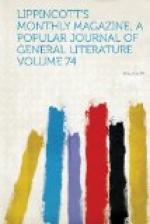It was something more than curiosity which made us alert to note the appearance and manner of this man, who has been so nearly associated with Miss Bronte in an intercourse which colored her whole subsequent life and determined her life work, who has been made the hero of her best novels and has even been deemed the hero of her own heart’s romance; and yet we were curious to know “what manner of man it is” who has been so much as suspected of being honored with the love and preference of the dainty Charlotte Bronte. During a short conversation with him we had opportunity to observe that in person this “wise, good, and religious” man must, at the time Miss Bronte knew him, have more closely resembled M. Pelet of “The Professor” than any other of her pen-portraits: indeed, after the lapse of more than forty years that delineation still, for the most part, aptly applies to him. He is of middle age, of rather spare habit of body; his face is fair and the features pleasing and regular, the cheeks are thin and the mouth flexible, the eyes—somewhat sunken—are of mild blue and of singularly pleasant expression. We found him elderly, but not infirm; his finely-shaped head is now fringed with white hair, and partial baldness contributes an impressive reverence to his presence and tends to enhance the intellectual effect of his wide brow. In repose his countenance shows a hint of melancholy: as Miss Bronte has said, “his physiognomy is fine et spirituelle;” one would hardly imagine it could ever resemble the “visage of a black and sallow tiger.” His voice is low and soft, his bow still “very polite, not theatrical, scarcely French,” his manner suave and courteous, his dress scrupulously neat. He accosted us in the language Miss Bronte taught him forty years ago, and his accent and diction do honor to her instruction. He was, at this time, engaged with some patrons of the school, and, as his daughter had hinted that he was averse to speaking of Miss Bronte, we soon took leave of him and were shown through other parts of the school. The other class-rooms, used for less advanced pupils, are smaller. In one of them, the third, Miss Bronte had ruled as monitress after her return from Haworth. The large dormitory of the pensionnat was above the long class-room, and in the time of the Brontes most of the boarders—about twenty in number—slept here. Their cots were arranged along either side, and the position of those occupied by the Brontes was pointed out to us at the extreme end of the long room. It was here that Lucy suffered the horrors of hypochondria, so graphically portrayed in “Villette,” and found the discarded costume of the spectral nun lying upon her bed, and here Miss Bronte passed those nights of “dreary, wakeful misery” which Mrs. Gaskell describes.




